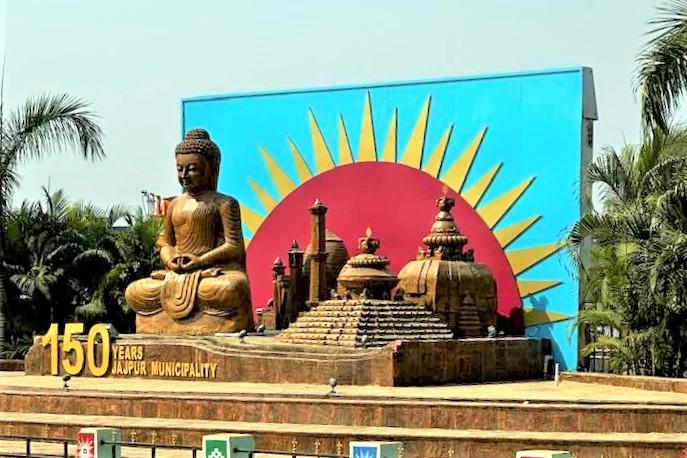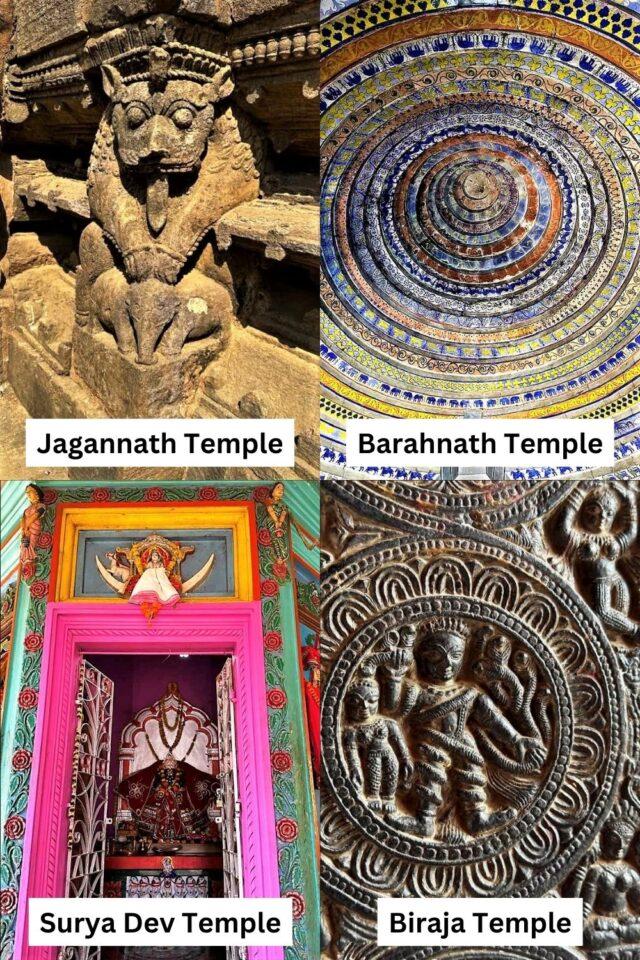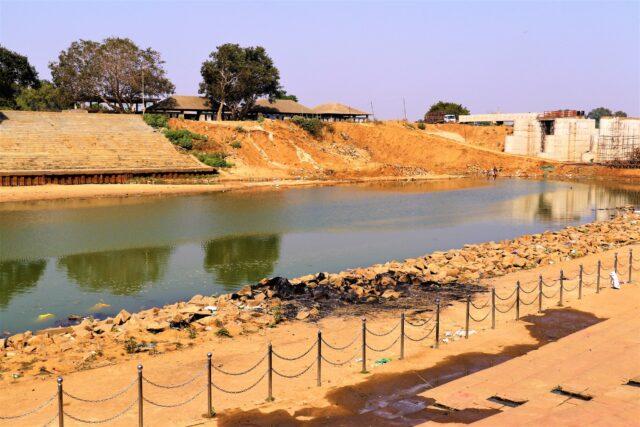12 BEST THINGS TO DO IN JAJPUR ODISHA
by Vagatrip
Have you ever come across the captivating city of Jajpur? If not, let me intrigue you with its charm and beauty. Nestled in the heart of Odisha, India, Jajpur is a hidden gem that often goes unnoticed. To be honest, I myself wasn't acquainted with this remarkable place until I received an invitation from Odisha Tourism to explore its tourist attractions and experience the wonders it had to offer.
During my three-day sojourn in Jajpur, I discovered a mesmerizing offbeat destination that left me awe-inspired. Eager to share my experience, I have meticulously crafted this essay and travel blog, hoping to shed light on this lesser-known corner of Odisha.
When we think of Odisha, it is usually the prominent names of Bhubaneswar, Puri, or the UNESCO heritage site, Sun Temple Konark, that spring to mind. However, thanks to the ongoing development efforts and promotional endeavors, Jajpur is swiftly making its way onto the tourism map of Odisha. Trust me when I say, it won't be long before this extraordinary place becomes a sought-after destination in India.
With its picturesque landscapes, rich cultural heritage, and a plethora of fascinating things to do, Jajpur has everything to enchant any traveler. From historic monuments to serene temples, from serene natural beauty to warm hospitality, this city has it all.
So, whether you are an adventurer seeking new experiences or a traveler yearning for an offbeat escape, Jajpur is the perfect destination for you. Don't miss the chance to explore this unique corner of India. Be sure to save this travel blog on Jajpur, Odisha, and let it guide you in planning a memorable trip to this emerging gem of a place.
Intrigue, wonder, and adventure await you in Jajpur. Embrace the allure of this lesser-explored destination, and let the beauty of Odisha's hidden treasure unfold before your eyes.

About Jajpur in Odisha
Before delving further into the exquisite details of the tourist attractions in Jajpur and the plethora of enjoyable activities to indulge in, let us take a moment to acquaint ourselves with the captivating essence of this charming place.
How Jajpur got its name?
This ancient city is known by various names, including Viraja, Baitarini Tirtha, Jajapur, and Parvati Teerth. Once upon a time, King Jajati established it as his capital, renaming it Jajapura to honor his legacy.
Interestingly, during our stay in Jajpur, we enjoyed the comfort and elegance of Jajati Courtyard, a charming hotel where we spent four delightful nights. More about our experience at Jajati Courtyard hotel will be shared in another post.
Before we delve into the wonders of Jajpur, let's explore the history of this remarkable place in a few concise words.
The earliest recorded account of Jajpur dates back to 473 CE. Chinese travelers' accounts mention Jajpur as a prominent capital in the 7th century, during the reign of Jajati Keshari, a king from the illustrious Somvanshi Dynasty. Subsequently, in the period after the 7th century A.D, the Bhaumkaras rose to power, becoming the rulers of Odisha with their capital situated near Viraja, known as Guheswar Patak.
This storied past has left an indelible mark on Jajpur, making it a treasure trove of historical significance and cultural heritage. Now, let's uncover the captivating sights and stories that Jajpur has to offer.
Religious Significance of Jajpur
Jajpur holds profound significance in ancient Indian mythology and Puranic literature, making it a revered destination and one of India's most important tirthas (pilgrimage sites). Numerous scriptures, such as the Kapilasamhita and Brahmanda Purana, make mention of this sacred place.
In the epic Mahabharata, an illustrious tale unfolds where the Pandava brothers, accompanied by the esteemed saint Lomash, undertook a sacred bath on the banks of the holy rivers Baitarini and Viraja at Jajpur. This act of devotion further adds to the sanctity and historical importance of this hallowed site.
Places to Visit in Jajpur Odisha
Temples of Jajpur
Discovering the plethora of temples in Jajpur can truly be an awe-inspiring experience, especially for spiritually inclined tourists! However, to make the most of your visit, one can selectively opt for the top temples that showcase the rich historical and architectural heritage of the region.
Here are five magnificent Jajpur Temples that perfectly fit into a one-day itinerary of this sacred place – Biraja Temple, Jagannath Temple, Barahnath Temples, Surya Dev Temple, and Sapta Matrika Temple. Conveniently situated in close proximity to one another, these temples can be comfortably explored within just a few hours.
Each of these revered sanctuaries holds within its walls a captivating tale of the past and represents unique architectural styles that have withstood the test of time. Embarking on a journey to these sacred sites allows one to delve into the spiritual essence of Jajpur and immerse in its profound cultural heritage.
So, whether you're a history enthusiast, an architecture admirer, or a seeker of divine experiences, the journey to these five temples promises to be a fulfilling and enriching one.
Biraja Temple Shakti Peeth
Among all the temples of Jajpura, the Biraja Temple stands out as the most popular one. This ancient marvel holds significant importance as it is recognized as one of the 18 major Shakti Peethas in India. Situated gracefully on the banks of the serene Vaitarini River, the temple welcomes visitors with open arms and is easily accessible by road, making it a convenient destination for devotees and travelers alike.
The grandeur of the temple complex is truly captivating, adorned with numerous shrines, and graced by the presence of a majestic Bakul tree (Spanish Cherry). The blend of tradition and modernity is evident in the subtle integration of some new constructions within the premises. It creates a seamless harmony between the old and the new, further enhancing the allure of this sacred site.
To fully immerse oneself in the divine ambiance of Biraja Temple, it is advisable to set aside a couple of hours for the visit. This generous timeframe allows visitors to experience the spiritual essence, relish the peaceful surroundings, and pay their respects at this cherished place of worship. The tranquility and spiritual energy prevailing within the temple complex offer a truly enriching experience for everyone.
In conclusion, the Biraja Temple holds a special place in the hearts of many, drawing countless devotees and tourists to its hallowed grounds. Its divine charm, accessible location, and serene environment make it a must-visit destination for those seeking solace and spiritual enlightenment.
Barahnath Temple
Welcome to the exquisite temple devoted to Barah (Varah, the Boar avatar of God Vishnu). The ceiling art within is truly remarkable, making it an absolute must-visit destination for all.
Surya Dev Temple
In the serene town of Jajpur lies a hidden gem - a small yet exquisitely painted temple dedicated to the revered Surya Bhagwan, the Sun God. The craftsmanship of the idol is truly awe-inspiring, portraying Surya seated gracefully on a majestic chariot, which is gracefully drawn by seven magnificent white horses.
Visitors to this enchanting place can also explore the Brahanath Temple, located in the same vicinity, allowing them to experience the divine aura of both temples within the span of just one hour. These temples are thoughtfully situated together, offering convenience to those seeking spiritual solace.
Amidst the spiritual aura of the temples, one can also find smaller shrines around, adding to the sacred ambiance of the place. Moreover, the upcoming colossal statue of God Shiva, currently under construction nearby, is anticipated to become yet another captivating attraction of Jajpur in the near future.
For anyone with an inclination towards divine beauty and spiritual exploration, this charming spot holds the promise of a truly enriching experience. As visitors bask in the divine presence, they are sure to find peace and tranquility amidst the artistry of the temples and the natural beauty that surrounds them.
Jagannath Temple of Jajapura
This revered temple holds a special place in the hearts of the locals as it is considered the second divine abode of God Jagannath, right after the renowned Puri Temple. Initially, this sacred site was established by King Anangabhimadeva of the Ganga dynasty, but regrettably, it suffered destruction during the invasion by Muslim forces.
Nevertheless, remnants of the original temple can still be admired on the platform supporting the present structure. These remnants stand as a testament to the exquisite craftsmanship and intricate carvings that adorned the original temple in ancient times.
The temple we see today, with its captivating facade, was later constructed by the illustrious Maratha King Raghuji Bhonsle during the latter half of the 18th century. The majestic architecture and deep-rooted history make this temple a place of profound significance and a cherished heritage site for all to appreciate.
Sapta Matrika Temple
The place's name signifies the "Temple of Seven Mothers," venerating the Goddesses Brahmani, Vaishnavi, Narasimhi, Chamunda, Indrani, and Varahi. Within the temple, you'll find exquisite idol representations of these deities, gracefully seated on lotus flowers. These beautifully adorned idols are housed in seven consecrated rooms, elegantly aligned within a rectangular hall. As sacred attendants of the revered Viraja Goddess, their presence exudes a divine aura that captivates all who visit the temple.
Please note – Photography is strictly prohibited in this temple.
There are no tickets required for entering the above temples.

Dashashwamedh Ghat Jajpur
Like the renowned Dashashwamedh Ghat of the Ganga River in Varanasi, the ghat situated on the banks of the Vaitarini River holds great significance, being closely associated with the origin of Jajpur as a capital city. Back in the 11th century, during the reign of the Somavanshi ruler Jajati Keshari, a momentous yagna (a sacred ritual performed in front of a consecrated fire) took place here, establishing Jajpur as the capital of his kingdom.
A series of steps gracefully lead down to the river, drawing countless pilgrims who arrive to perform rituals for their ancestors. The Vaitarini River flows serenely, concealing numerous mysteries, including ancient idols that were discreetly immersed by the priests of nearby temples to protect them from potential damage during the turbulent times of Muslim invasions. Notably, in April 2022, a remarkable discovery was made, with several rare idols resurfacing from the riverbed, adding further intrigue to its storied past. (Read more: Six rare idols recovered from Baitarani River.)
This sacred ghat, like many others across the country, bears witness to the rich tapestry of history and tradition, drawing visitors and devotees alike to its timeless allure.

Buddhist Heritage of Jajpur
The Buddhist circuit in Odisha, also referred to as the "Diamond Triangle," encompasses three significant sites: Lalitgiri in Cuttack district, and Udaygiri and Ratnagiri in Jajpur district. These locations hold immense historical and cultural importance for followers of Buddhism and attract visitors from all around the world.
Udaygiri Buddhist Monastery:
Among the three sites forming the triangle, Udaygiri stands as the largest and most expansive, though still relatively unexplored. Its vast area offers visitors the opportunity to wander through the remnants of two ancient monasteries, adorned with awe-inspiring sculptures and the vestiges of Mahastupas and prayer halls. The crowning glory of this site is the mesmerizing panoramic view one can behold from the hilltop.
Exciting developments are on the horizon for Udaygiri, as plans are underway to enhance the visitor experience. In the coming years, the area will see the establishment of charming cafes and the introduction of solar-powered vehicles, which will make reaching the far-flung corners of the site a breeze.
Nature enthusiasts will find delight in the wide variety of native bird species inhabiting the surroundings. For birdwatchers equipped with only a 135mm lens, capturing these winged beauties might pose a challenge against the radiant blue sky. In such cases, a zoom lens comes highly recommended. Allow a generous 2 to 3 hours, if not more, to fully immerse yourself in the wonders of Udaygiri. (For more information, refer to "What to see in Udayagiri Buddhist Complex, Odisha").
Ratnagiri:
Comparatively smaller in size than Udaygiri, Ratnagiri can be conveniently explored within a single hour. Despite its compactness, historians have determined this site to have once been a significant Buddhist monastery in India. Positioned strategically on a hill amidst the convergence of the Brahmani and Birupa rivers in Jajpur district, Ratnagiri lies just 13.5 km east of Udaygiri Buddhist Monastery. The potential for further excavations promises to unveil a wealth of untold discoveries.
During our visit, we were privileged to catch a glimpse of the sacred curls of Buddha's hair, hinting at the remarkable treasures buried within. The prospect of unearthing additional ruins is undoubtedly tantalizing.
Of particular note is the enchanting blue-green chlorite robust door frame, a structure that bears its own captivating story.
Please be advised that tickets are required for entry to both the above-mentioned monasteries.